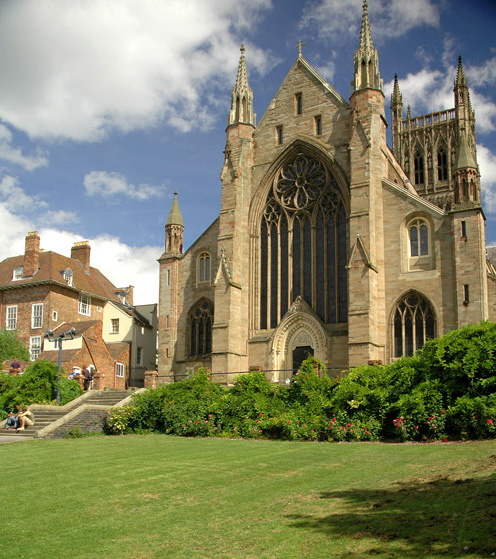The Organisation within a Monastery
Although early medieval monasteries were commonly very small houses lived in by small groups of monks, they rapidly developed to become some of the most impressive buildings in Medieval England built around communities of monks.
As monasteries grew in size, it was vital that the monastery remained disciplined to ensure efficiently while focusing on the worship of God. The writings of St Benedict on how best to run a medieval monastery were particularly influential, and in 530 AD he even created a rule book that stated the appropriate behaviour for monks with a focus on taking vows.
According to St Benedict, every monk should be required to take a vow of poverty and should live just as the poor did. This also meant dressing as though they had taken this vow, wearing only functional clothing that was warm in the winter and cool in the summer. Monks were also required to obey an abbot, take a vow of chastity and not marry, and should also live amongst other monks as part of a community. The books created by St Benedict were written in Latin, and as such this became the language in which monks would write.

The working day was commonly split into three parts: the working section where certain tasks should be performed, the studying sections where monks would have to read and learn, and the prayer section. This last part required monks to pray, listen to the abbot or read the bible. All sections of the day were thought to reflect St Benedict’s belief that monks should have a lifestyle that represented the simple essentials.
An abbot would take charge of the monastery, and on significant days such as Saints Days he would wear a hat very similar to a bishop’s mitre. An abbot would also carry a crozier to symbolise his authority.
Each medieval monastery would be blessed by a patron - wealthy men able to spare money to cover the construction costs. King Edward the Confessor, for example, contributed to the costs of building Westminster Abbey, while French kings were patrons of the abbey as it was built in St. Denis’ honour. Patrons were also expected to help protect the monastery if it was threatened by an intruder as monasteries frequently contained very valuable treasures.
As well as having patrons, individual monasteries would dedicate themselves to a saint. This name may they be reflected in the town in which the monastery resided, such as in St. Albans or Bury St. Edmunds.
Life inside the monastery
Each day in a monastery was very structured and revolved around prayer. Service times differed but most named the first service ‘Vigils’, and this would be held at 2am. The service that followed would take place at dawn and was known as ‘Matins’, although the timing for this would change with the seasons. ‘Prime’ was held at 6am, followed by ‘Tierce’ at 9am and ‘Sext’ at 12 noon. Monks would they pray at 3pm for ‘Nones’, at dusk for ‘Vespers’ and at nightfall for ‘Compline’.
The layout and facilities inside a medieval monastery was unique to England, with the size of the buildings far greater than the typical peasant home. Monks would be provided with dormitories where they could sleep, along with study areas in covered cloisters or a library. Larger monasteries also contained kitchens and benefited from flowing water and toilets. The church would always be the central point of the monastery, while a chapter house would be placed within its walls to provide a place for monks to hear a chapter of monastic rules each day.
Other than religious prayer and duties, monks also had other work to complete each day. This included working in the kitchen, tending to livestock, brewing beer - which was healthier than water - producing books, tending to guests or helping in the infirmary.
St Benedict also suggested that monks should look after the poor in a building known as an almonry. Inside the almonry, ‘almoners’ would feed the poor left over food and also tend to their feet if they were on a long pilgrimage. ‘Hostellers’ were responsible for looking after visitors with a higher social ranking, who would often provide the monastery with gifts of thanks. Although when King John stayed at the monastery in St. Albans for 10 days, he famously only left them 13 pence.
Some monasteries became very wealthy as a result of the gifts they received, and many also benefited from free labour from local peasants. These peasants felt they were more likely to get into Heaven if they helped the monks, which saved the monasteries a great deal of money each year.
Monasteries could even gather treasure over time, with some owning gold, silver and jewelled boxes containing religious relics. Examples of some of these treasures include the bones of saints, which Harold of Wessex would have had to swear on in front of William the Conqueror before the Battle of Hastings, or the clothing of saints. Glastonbury’s monastery in particular was thought to be one of the wealthiest in England during the Middle Ages.
MLA Citation/Reference
"The Organisation within a Monastery". HistoryLearning.com. 2024. Web.
